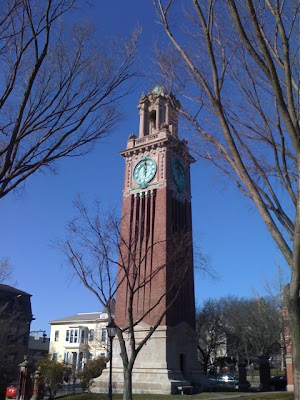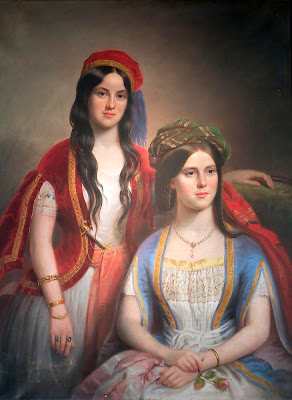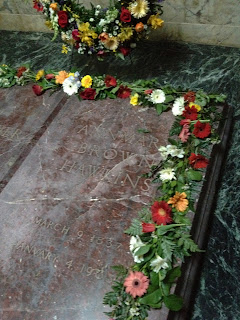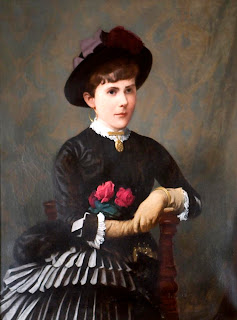Two men who might otherwise have never met each other--one a New York politician and military man, the other an Italian count and diplomat--erected structures on the Brown University campus in the first decade of the 20th century to honor the women they loved, wed, and lost. But they did meet each other, in fact became brothers-in-law, because the two women happened to be sisters, Annmary and Caroline (Carrie) Brown. They were granddaughters of Nicholas Brown, Jr., who had given the university (then known as the College of Rhode Island) $5,000 and his name in 1804.
 |
| Carrie Tower |
 |
| Annmary Brown Memorial |
 |
| Annmary and Carrie Brown as teenagers |
It was at Choppequonsett that Annmary, who was already suffering from the respiratory ailments that would plague her throughout her life, married Rush Hawkins of New York City in the summer of 1860. Before they had been married a year, he would form the Hawkins Zouaves and spend the next four years leading his troops in the Civil War.
During Rush's absence, Carrie was Annmary's companion and caretaker, and the sisters grew even closer. After the war was over, General Hawkins and Annmary spent their winters in South Carolina, California, and Florida, and they also traveled abroad extensively.
By this time, Carrie was in her thirties, and seemed resigned to life as a spinster. But things changed dramatically when Paul Bajnotti, an Italian count and diplomat, showed up in Rhode Island in 1875 and swept her off her feet. Carrie and Paul were also wed at "Choppe", and in the years to follow, the Bajnottis would accept diplomatic postings to Paris, Rome, St. Petersburg, and elsewhere. Meanwhile, Rush and Annmary would search for a cure for Annmary all over the world--Nice, Charleston, Paris, Cairo--always hoping that new techniques or warmer temperatures would alleviate the catarrah, bronchitis, and lung congestion that sent her to bed for weeks at a time.
 |
| General Rush Hawkins |
By this time, Carrie was in her thirties, and seemed resigned to life as a spinster. But things changed dramatically when Paul Bajnotti, an Italian count and diplomat, showed up in Rhode Island in 1875 and swept her off her feet. Carrie and Paul were also wed at "Choppe", and in the years to follow, the Bajnottis would accept diplomatic postings to Paris, Rome, St. Petersburg, and elsewhere. Meanwhile, Rush and Annmary would search for a cure for Annmary all over the world--Nice, Charleston, Paris, Cairo--always hoping that new techniques or warmer temperatures would alleviate the catarrah, bronchitis, and lung congestion that sent her to bed for weeks at a time.
The two couples got together in Europe whenever possible--each man was genuinely fond of his wife's sister, and since there were no children, the four became a close-knit family.
Given Annmary's respiratory history, it is surprising that Carrie was the first to die; she contracted the flu, and died in Palermo in 1893, after her illness escalated to pneumonia. Hawkins wrote that Paul was "sorrowing and heart-broken", and was determined to memorialize his wife in her hometown of Providence. After an extensive competition he selected architect Guy Lowell to design the clock tower known as Carrie Tower. (Lowell would later design the Boston Museum of Fine Arts.) The tower was built in 1904 on the Brown campus, just within the wrought iron fence that demarcates the front campus, at the corner of Prospect and Waterman Streets. "Love is Strong as Death" is inscribed on the foundation. Carrie herself was buried at the English cemetery in Rome.
The inscription on Carrie Tower
|
 |
| Annmary Brown Hawkins |
Possibly inspired by the planned memorial to Carrie, Hawkins hired the Rhode Island architect Norman Isham to design a mausoleum and museum at 21 Brown Street. Hawkins had an extensive book collection, and the building, which was completed in 1907, was designed to serve as a memorial to Annmary, the final resting place for the couple, and a museum for his books, paintings, Civil War relics, and other personal collections.
An inscription on the marble floor slab that marks Annmary's burial reads: "Like some rare flower entombed in its beauty, shedding everlasting."
Postscript
Count Bajnotti also erected a fountain in Carrie's memory in Burnside Park in Providence, designed and built between 1898-1902. He died in 1919 in Turin, Italy.
General Hawkins died one year later, when he was hit by a car on Fifth Avenue in NYC. Every year until his death, he placed fresh flowers on Annmary's tomb on her birthday (March 9), flowers which were left to wither until the following year (thus matching the inscription there). Hawkins left money in his will so that this practice could be continued, and it does to this day.
In 1948, the Annmary Brown Memorial was transferred to the ownership of Brown University, and today it houses the Medieval Studies Department, as well as collections of toys, swords, art, and furniture. General Hawkins' books, which included a collection of 225 books from 130 of the 238 fifteenth-century presses, were moved to the John Hay Library in 1990. Hawkins' Civil War collection has been in the news recently--Brown is suing collector Donald Thorpe for the return of a silver sword presented to General Hawkins in 1863; the University claims it was stolen from the Annmary Brown Memorial in the 1970s.
In the 1950s, the clocks on Carrie Tower began to run erratically--it was determined that an essential mechanism had been removed as part of a prank. Today the clocks do not move-they are set at 12.
An inscription on the marble floor slab that marks Annmary's burial reads: "Like some rare flower entombed in its beauty, shedding everlasting."
 |
| Annmary Brown tomb with fresh flowers |
Count Bajnotti also erected a fountain in Carrie's memory in Burnside Park in Providence, designed and built between 1898-1902. He died in 1919 in Turin, Italy.
General Hawkins died one year later, when he was hit by a car on Fifth Avenue in NYC. Every year until his death, he placed fresh flowers on Annmary's tomb on her birthday (March 9), flowers which were left to wither until the following year (thus matching the inscription there). Hawkins left money in his will so that this practice could be continued, and it does to this day.
In 1948, the Annmary Brown Memorial was transferred to the ownership of Brown University, and today it houses the Medieval Studies Department, as well as collections of toys, swords, art, and furniture. General Hawkins' books, which included a collection of 225 books from 130 of the 238 fifteenth-century presses, were moved to the John Hay Library in 1990. Hawkins' Civil War collection has been in the news recently--Brown is suing collector Donald Thorpe for the return of a silver sword presented to General Hawkins in 1863; the University claims it was stolen from the Annmary Brown Memorial in the 1970s.
In the 1950s, the clocks on Carrie Tower began to run erratically--it was determined that an essential mechanism had been removed as part of a prank. Today the clocks do not move-they are set at 12.
Illustration Credits and References
Descriptions of both women are on the Find a Grave website; find Carrie and Annmary.
Some story elements were adapted from a paper written by Blair Hickman for a course in Nonfiction Writing at Brown in 2006; while plagued with sloppy editing on dates and ages, the paper is infused with information from two tribute volumes by Rush Hawkins which can be found in the Brown Archives, and which I did not pursue. The quotes from Rush Hawkins in this post come from the Hickman paper.
The portraits of Annmary and Carrie, as well as various bits of information about them, were found on several Brown University web pages, including their Portrait Collection pages and Encyclopedia Brunonia.
The portrait of Rush Hawkins was found in an article entitled "The Joy of Collecting Civil War Era Newspapers" on the Fine Art Registry website.
The exterior photos of the tower and mausoleum were taken by the author in February, 2012. The tombstone photograph was taken by the author on March 9th, 2012, and posted to this blog on that date.


Saint Stephens church has a stained glass window created by Tiffany from Annmary to her sister Carrie in the Lady Chaple
ReplyDeleteThanks so much for this information! I will put it on my list of things to visit in Providence.
Delete